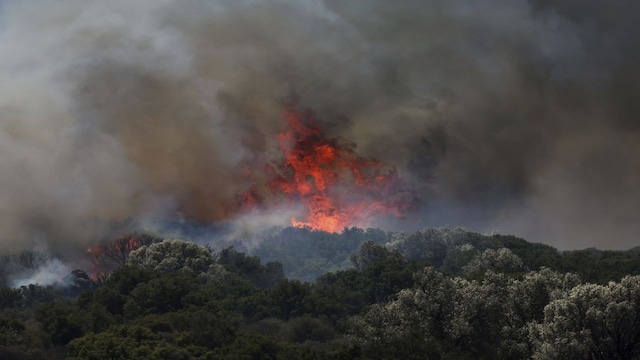
Record Breaking Temperatures Across Europe | England had its hottest June ever at 16.9°C, and the UK its second-warmest since 1884. Spain set a record with a 23.6°C average, while Portugal hit 46.6°C. Paris touched 38°C and parts of France reached 41.5°C, prompting red alerts. Germany issued heat warnings for cities like Dusseldorf and Stuttgart. Italy put 17 cities on maximum heat alert as temperatures crossed 40°C. (Image: Reuters)

Hundreds of Lives Lost | Europe’s heatwave has claimed over 680 lives so far, with the toll continuing to rise. The UK alone has recorded an estimated 570 heat-related deaths within days, while Spain has reported at least 114 fatalities, primarily among the elderly and vulnerable. (Image: Reuters)

What’s Driving the Extreme Heat | A heat dome—a high-pressure system that traps heat in the lower atmosphere—is currently parked over Europe. These domes have tripled in frequency and intensity since the 1950s, according to climate researchers. The Azores High, a dominant pressure system in the North Atlantic, has extended further into Europe, worsening the impact.

Fast Spreading Wildfires | The extreme heat has triggered fast-spreading wildfires across several countries. In Turkey, blazes in five districts forced over 50,000 people to evacuate, leaving dozens injured and one hospitalised. Greece faced a major wildfire on Chios island, which scorched 15,000 acres of forest before being brought under control. Meanwhile, Portugal is tackling multiple active fires, pulling urban firefighters to help protect rural areas at risk. (Image: AP)

Why Europe is at Greater Risk | Climate change is turning once-in-a-century heatwaves into frequent disasters. A study led by Prof. Lucarini finds European heatwaves are now up to 2.5°C hotter and drier than in past decades. Europe’s geography adds to the danger. Warming 0.5°C per decade—more than double the global average—it’s now the fastest-warming continent. Southern Europe’s location between the dry subtropics and wetter north, combined with a double jet stream, traps heat and fuels prolonged events. Since 2000, 23 of the 30 worst heatwaves since 1950 have occurred. (Image: AP)

Heatwaves Hurt Europe’s Economy | Heatwaves could cut Europe’s economic growth by up to 0.5 percentage points in 2025, according to Allianz Research, which compares a day over 32°C to half a day of strikes in economic impact. GDP losses range from 0.1 points in Germany to 1.4 in Spain. Globally, extreme heat may reduce GDP by 0.6 points this year. Heat stress is also expected to reduce global working hours by 2.2% by 2030, the International Labour Organization (ILO) warns. Allianz urges structural changes to help cities and workplaces adapt. (Image: AP)

What Counts as A Heatwave in Europe | Heatwaves are defined as three or more days of higher-than usual temperatures. But the threshold varies by region. In Athens, temperatures must stay above 39°C to count as a heatwave. Meanwhile, in Helsinki, just 25°C over several days meets the criteria. (Image: Reuters)

What’s Ahead | Europe’s heatwaves are no longer rare. Climate change is turning European summers into prolonged public health emergencies. If emissions remain unchecked, extreme weather events will become more frequent and intense, and these blistering temperatures will only rise. (Image: AP)
